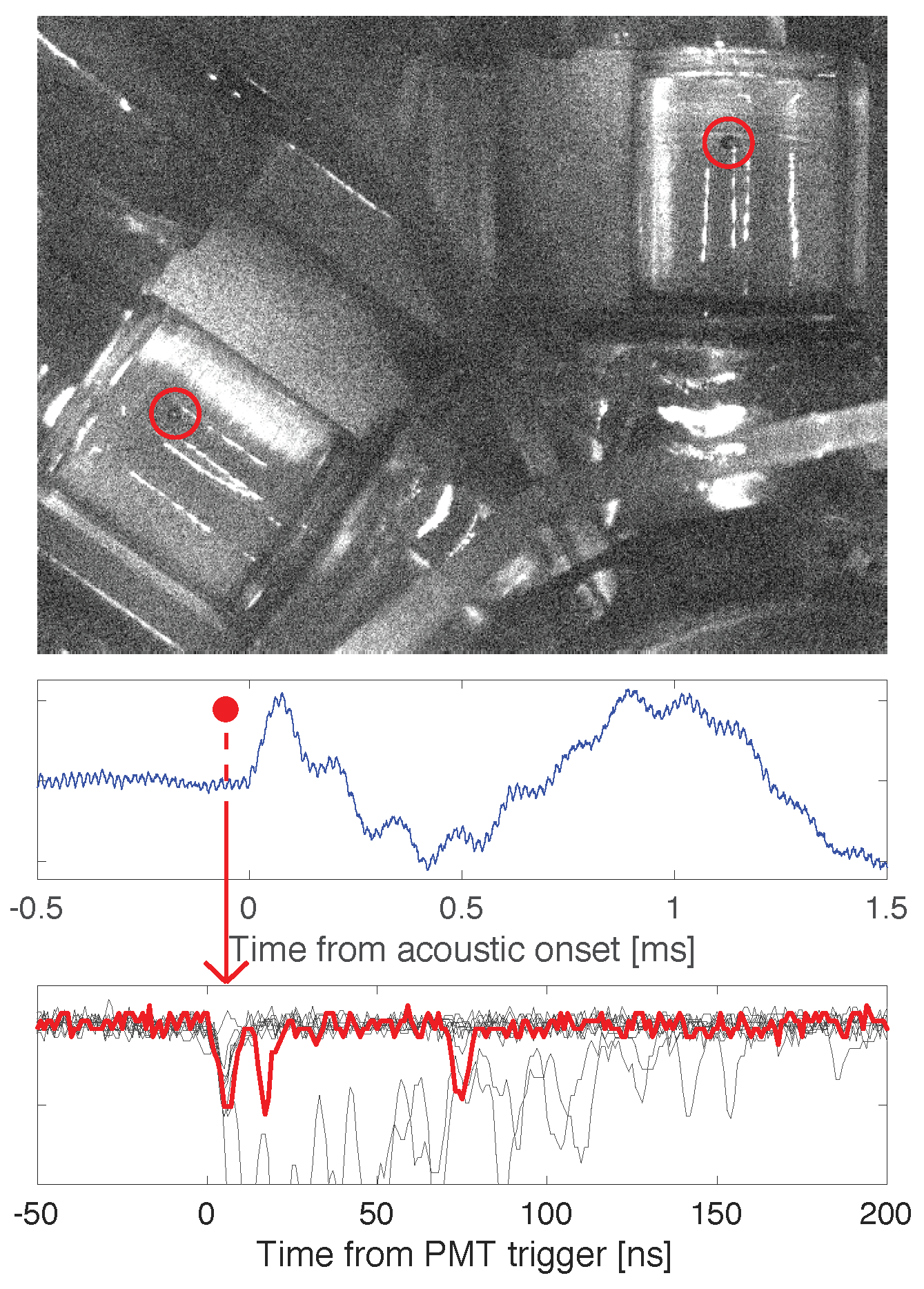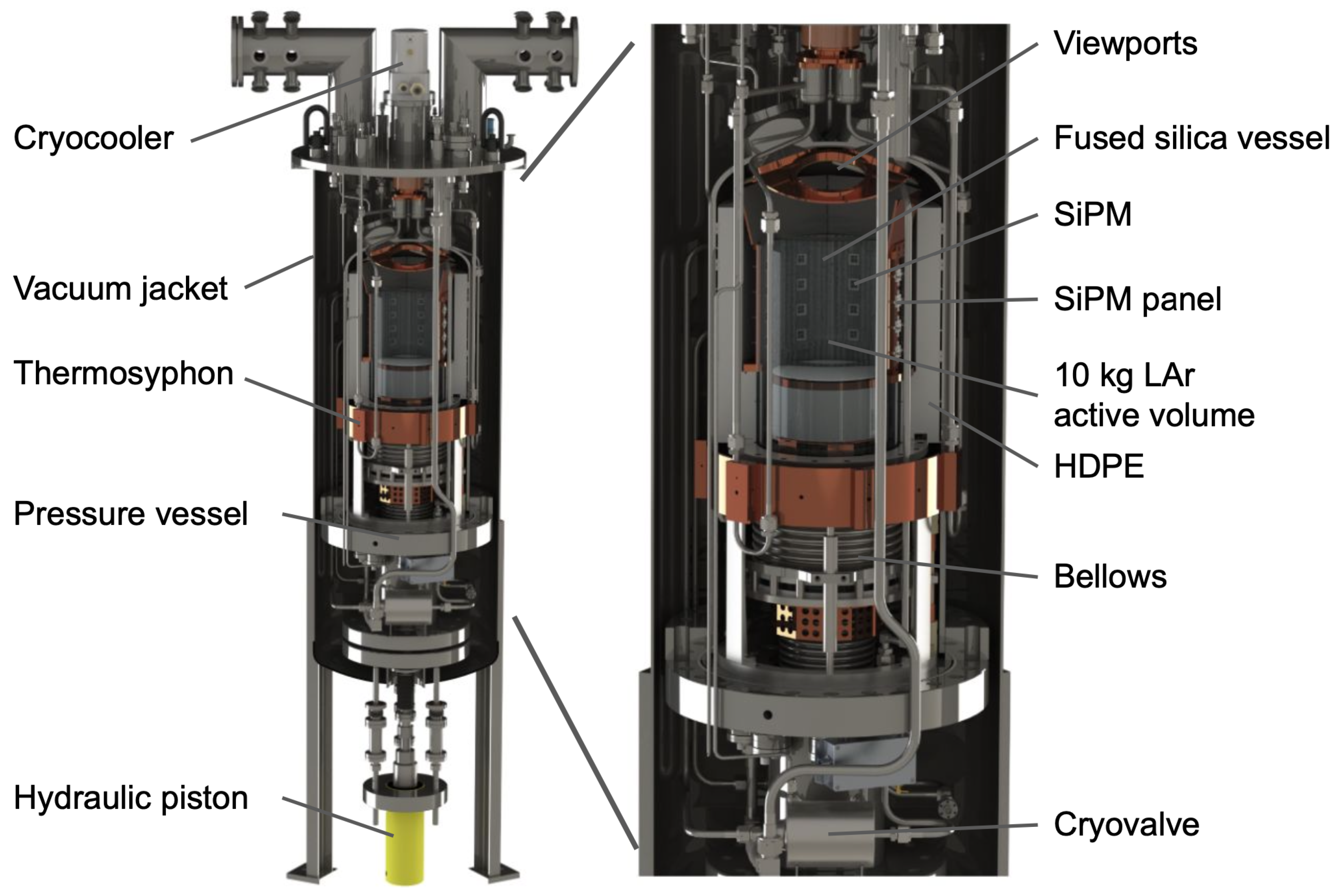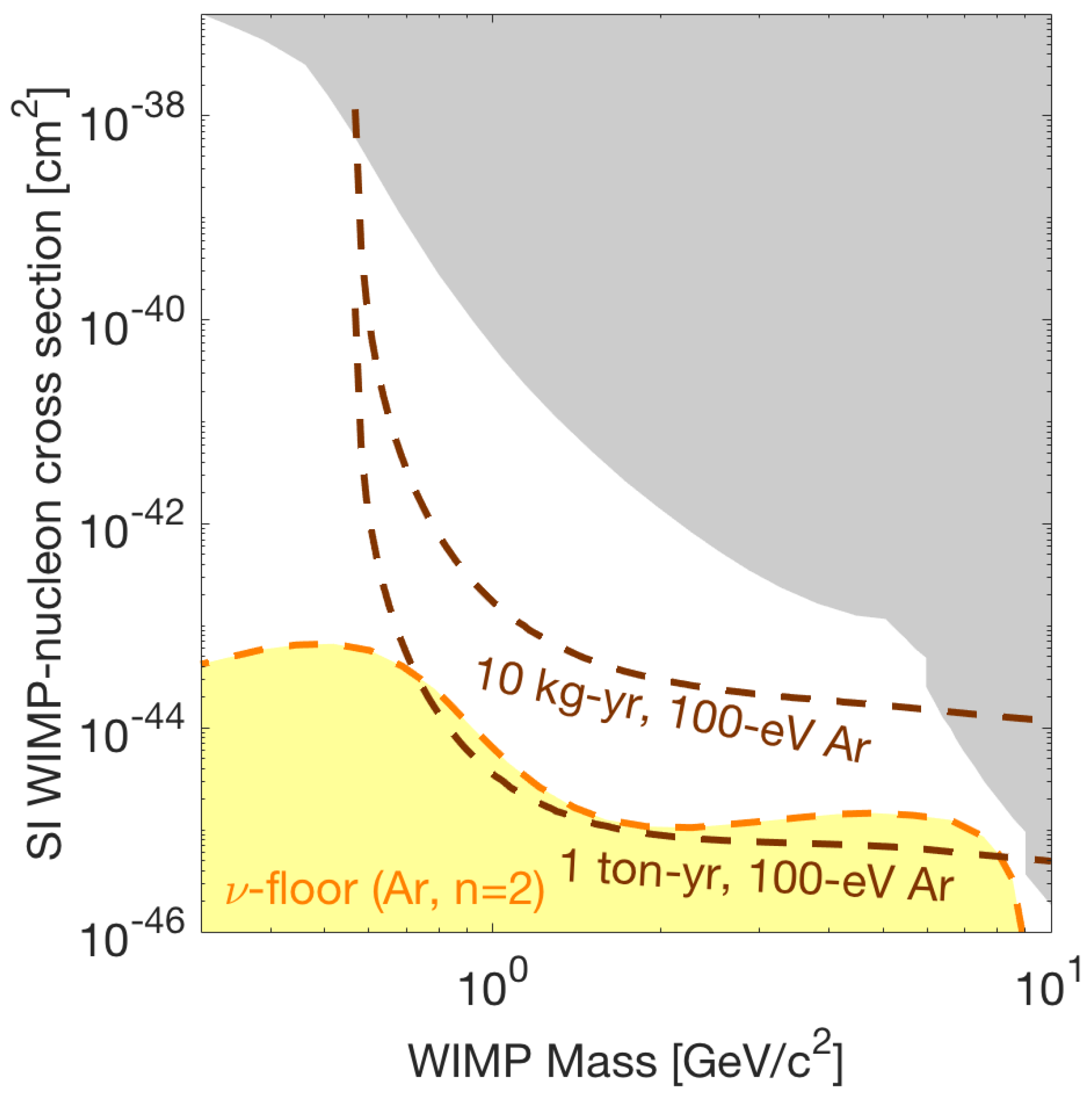Scintillating Bubble Chambers for Rare Event Searches †
Abstract
1. Introduction
2. Scintillating Bubble Chambers
3. SBC-LAr10 Detector Design
4. Operational Strategies and Expected Backgrounds
5. Current Status and Physics Reach
Author Contributions
Funding
Data Availability Statement
Conflicts of Interest
| 1 | A modern review of radiation-induced nucleation in bubble chambers is given in [8]. |
| 2 | One goal of the SBC-LAr10 detector is to confirm this hypothesis. |
References
- Bertone, G.; Hooper, D.; Silk, J. Particle dark matter: Evidence, candidates and constraints. Phys. Rep. 2005, 405, 279. [Google Scholar] [CrossRef]
- Davidson, A. B-L as the fourth color within an SU(2) L× U(1) R× U (1) model. Phys. Rev. D 1979, 20, 776. [Google Scholar] [CrossRef]
- Alfonso-Pita, E. et al. [SBC collaboration] Snowmass 2021 Scintillating Bubble Chambers: Liquid-noble Bubble Chambers for Dark Matter and CEνNS Detection. arXiv 2022, arXiv:2207.12400. [Google Scholar]
- Cohen, T.; Phalen, D.J.; Pierce, A.; Zurek, K.M. Asymmetric Dark Matter from a GeV Hidden Sector. Phys. Rev. D 2010, 82, 056001. [Google Scholar] [CrossRef]
- Behnke, E. et al. [COUPP collaboration] Spin-dependent WIMP limits from a bubble chamber. Science 2008, 319, 933. [Google Scholar] [CrossRef]
- Amole, C. et al. [PICO collaboration] Dark matter search results from the complete exposure of the PICO-60 C3F8 bubble chamber. Phys. Rev. D 2019, 100, 022001. [Google Scholar] [CrossRef]
- Seitz, F. On the theory of the bubble chamber. Phys. Fluids 1958, 1, 2–13. [Google Scholar] [CrossRef]
- Amole, C. et al. [PICO collaboration] Data-driven modeling of electron recoil nucleation in PICO C3F8 bubble chambers. Phys. Rev. D. 2019, 100, 082006. [Google Scholar] [CrossRef]
- Amole, C. et al. [PICO collaboration] Dark matter search results from the PICO-60 CF3I bubble chamber. Phys. Rev. D 2016, 93, 052014. [Google Scholar] [CrossRef]
- Bolozdynya, A.I. Emission Detectors; World Scientific: Singapore, 2010. [Google Scholar]
- Lindhard, J.; Scharff, M. Energy dissipation by ions in the keV region. Phys. Rev. 1961, 124, 128. [Google Scholar] [CrossRef]
- Baxter, D.; Chen, C.J.; Crisler, M.; Cwiok, T.; Dahl, C.E.; Grimsted, A.; Gupta, J.; Jin, M.; Puig, R.; Temples, D.; et al. First Demonstration of a Scintillating Xenon Bubble Chamber for Detecting Dark Matter and Coherent Elastic Neutrino-Nucleus Scattering. Phys. Rev. Lett. 2017, 118, 231301. [Google Scholar] [CrossRef] [PubMed]
- Bressler, M.J. Operation and Calibration of Right-Side-Up Bubble Chambers at ∼keV Thresholds: Towards New Superheated Dark Matter Searches. Ph.D. Thesis, Drexel University, Philadelphia, PA, USA, 2022. [Google Scholar]
- Bradley, A.W. LUX Thermosyphon Cryogenics and Radon-Related Backgrounds for the First WIMP Result. Ph.D. Thesis, Case Western Reserve University, Cleveland, OH, USA, 2014. [Google Scholar]
- Giroux, G. Search for Dark Matter with the PICO-500 Experiment. J. Phys. Conf. Ser. 2021, 2156, 012068. [Google Scholar] [CrossRef]
- Robinson, A.E. Coherent photon scattering background in sub-GeV/c2 direct dark matter searches. Phys. Rev. D 2017, 95, 021301, Erratum in Phys. Rev. D 2017, 95, 069907. [Google Scholar] [CrossRef]
- Ali, B. et al. [PICO collaboration] Determining the bubble nucleation efficiency of low-energy nuclear recoils in superheated C3F8 dark matter detectors. Phys. Rev. D 2022, 106, 122003. [Google Scholar] [CrossRef]
- O’Hare, C.A.J. New Definition of the Neutrino Floor for Direct Dark Matter Searches. Phys. Rev. Lett. 2021, 127, 251802. [Google Scholar] [CrossRef]
- Agnes, P. et al. [DarkSide-50 collaboration] Search for dark-matter–nucleon interactions via Migdal effect with DarkSide-50. Phys. Rev. Lett. 2023, 130, 101001. [Google Scholar] [CrossRef]
- Agnes, P. et al. [DarkSide-50 collaboration] Low-mass dark matter search with the DarkSide-50 experiment. Phys. Rev. D 2018, 121, 081307. [Google Scholar] [CrossRef]
- Aprile, E. et al. [XENON1T collaboration] Dark matter search results from a one ton-year exposure of XENON1T. Phys. Rev. Lett. 2018, 121, 111302. [Google Scholar] [CrossRef]
- Aprile, E. et al. [XENON1T collaboration] Light dark matter search with ionization signals in XENON1T. Phys. Rev. Lett. 2019, 123, 251801. [Google Scholar] [CrossRef]
- Aguilar-Hernández, F. Mexican TRIGA MARK III Reactor; International Atomic Energy Agency: Vienna, Austria, 2015. [Google Scholar]
- Flores, L.J. et al. [CEνNS Theory Group at IF-UNAM, SBC collaboration] Physics reach of a low threshold scintillating argon bubble chamber in coherent elastic neutrino-nucleus scattering reactor experiments. Phys. Rev. D 2021, 103, L091301. [Google Scholar] [CrossRef]
- Alfonso-Pita, E.; Flores, L.J.; Peinado, E.; Vázquez-Jáuregui, E. New physics searches in a low threshold scintillating argon bubble chamber measuring coherent elastic neutrino-nucleus scattering in reactors. Phys. Rev. D 2022, 105, 113005. [Google Scholar] [CrossRef]
- Akerib, D.S.; Cushman, P.B.; Dahl, C.E.; Ebadi, R.; Fan, A.; Gaitskell, R.J.; Galbiati, C.; Giovanetti, G.K.; Gelmini, G.B.; Grandi, L.; et al. Snowmass 2021 Cosmic Frontier Dark Matter Direct Detection to the Neutrino Fog. arXiv 2022, arXiv:2203.08084. [Google Scholar]




| Target fluid | Xe-doped Ar, |
| with options for pure Ar, Xe, N, or CF | |
| Fiducial volume | 10 L (10 kg LAr at 130 K) |
| Thermodynamic regulation | ±0.5 K, ±0.1 bar (±5 eV Seitz threshold) |
| Seitz threshold | Down to 40 eV (LAr at 1.4 bara, 130 K) |
| Scintillation detection | 1 photon per 5 keV NR in Xe-doped argon |
| Bubble imaging | stereoscopic at 100 fps with mm-resolution |
| Acoustic reconstruction | Time-of-nucleation reconstructed to |
| ±25 s resolution |
Disclaimer/Publisher’s Note: The statements, opinions and data contained in all publications are solely those of the individual author(s) and contributor(s) and not of MDPI and/or the editor(s). MDPI and/or the editor(s) disclaim responsibility for any injury to people or property resulting from any ideas, methods, instructions or products referred to in the content. |
© 2023 by the authors. Licensee MDPI, Basel, Switzerland. This article is an open access article distributed under the terms and conditions of the Creative Commons Attribution (CC BY) license (https://creativecommons.org/licenses/by/4.0/).
Share and Cite
Alfonso-Pita, E.; Behnke, E.; Bressler, M.; Broerman, B.; Clark, K.; Corbett, J.; Dahl, C.E.; Dering, K.; de St. Croix, A.; Durnford, D.; et al. Scintillating Bubble Chambers for Rare Event Searches. Universe 2023, 9, 346. https://doi.org/10.3390/universe9080346
Alfonso-Pita E, Behnke E, Bressler M, Broerman B, Clark K, Corbett J, Dahl CE, Dering K, de St. Croix A, Durnford D, et al. Scintillating Bubble Chambers for Rare Event Searches. Universe. 2023; 9(8):346. https://doi.org/10.3390/universe9080346
Chicago/Turabian StyleAlfonso-Pita, Ernesto, Edward Behnke, Matthew Bressler, Benjamin Broerman, Kenneth Clark, Jonathan Corbett, C. Eric Dahl, Koby Dering, Austin de St. Croix, Daniel Durnford, and et al. 2023. "Scintillating Bubble Chambers for Rare Event Searches" Universe 9, no. 8: 346. https://doi.org/10.3390/universe9080346
APA StyleAlfonso-Pita, E., Behnke, E., Bressler, M., Broerman, B., Clark, K., Corbett, J., Dahl, C. E., Dering, K., de St. Croix, A., Durnford, D., Giampa, P., Hall, J., Harris, O., Hawley-Herrera, H., Jackson, C. M., Ko, Y., Lamb, N., Laurin, M., Levine, I., ... Zhang, R. (2023). Scintillating Bubble Chambers for Rare Event Searches. Universe, 9(8), 346. https://doi.org/10.3390/universe9080346






